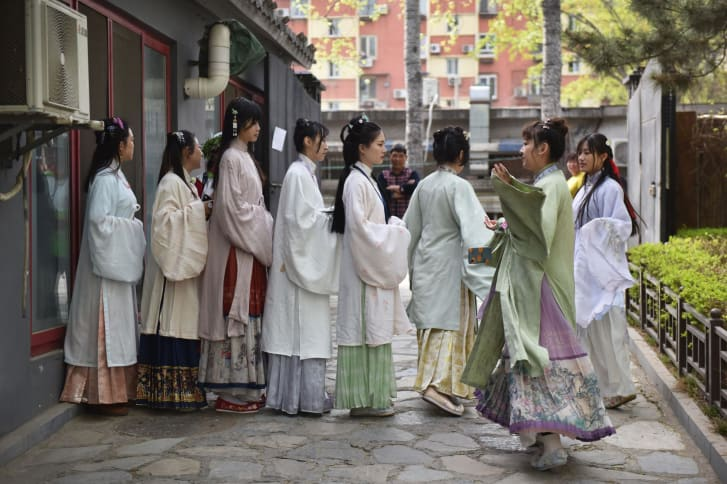
On the streets of Chinese cities, young people can increasingly be seen wearing clothing with “neo-Chinese elements.” This style combining modern and traditional clothing such as qipao or hanfu has become a new favorite for younger generations, who have more confidence than ever in traditional Chinese culture.
Although not a new phenomenon, searches for “Neo-Chinese Style” have recently increased. Following the publication of a white paper titled “2022 Taobao and Tmall Apparel Industry Trends Report” on August 26, the hashtag(标签) “Why has neo-Chinese style gone viral?” has been popular on Weibo and got more than 230 million views. A search on Xiaohongshu reveals the hashtag “Neo-Chinese Style” has been viewed about 130 million times, while “Neo-Chinese Style Outfits” has been viewed more than 72 million times. A report about recent fashion trends noted that neo-Chinese fashion has mainly become popular among 18- to 34-year-olds, while women aged 24-34 years old account for 40 percent of the consumer group. They are undoubtedly the most significant players shaping the Chinese fashion industry. Moreover, they are embracing a variety of more diverse styles, including the neo-Chinese style.
Neo-Chinese clothing is one of the most popular fields among younger generations, who prefer clothing that integrates traditional Chinese elements into daily wear. This has inspired Chinese designers to use more traditional ornaments(饰物). Compared with traditional hanfu or Tang jackets, neo-Chinese dresses exchange a sense of ceremony for a more simple and convenient feel.
“The modern yet traditional aesthetics(美学的) of neo-Chinese fashion intrigues young consumers because it represents ‘who they are’ through dress-up. It is a ‘way to send a message,’ speaking of their open mind about cultural diversity,” Fang Qiongyi, a cultural sociologist in Shanghai said.
Neo-Chinese style has spread into many fields, including neo-Chinese tea, neo-Chinese baking and neo-Chinese home decor. And some international luxury brands also create China-specific designs. But before global companies jump on the trend, they should be careful about crediting the culture.
本时文内容由奇速英语国际教育研究院原创编写,未经书面授权,禁止复制和任何商业用途,版权所有,侵权必究!(作者投稿及时文阅读定制请联系微信:18980471698)
1.What does the data in Paragraph 2 mainly show?
A Why neo-Chinese style is popular.
B How popular neo-Chinese style is.
C What 2021’s fashion trends were.
D Who is shaping the global fashion industry.
解析:选B。B推理判断题。根据该段的中心句“Although not a new phenomenon, searches for ‘Neo-Chinese Style’ have recently increased.”可知,该段主要讲了最近越来越多的人搜索“新中式风”,为了证实这一点,作者例举了很多数据。这些数据都反应了“新中式风”的风靡程度。故选B。
2.Younger generations’ preference for “neo-Chinese elements” brings __________.
A less traditional Chinese elements’ recognition
B fewer simple and convenient feelings
C frequent use of traditional ornaments
D the failure to embrace a variety of more diverse styles
解析:选C。C细节理解题。根据第三段第二句“This has inspired Chinese designers to use more traditional ornaments.”可知,中国年轻一代喜欢将传统中国元素融入日常穿着的服装,这激励了中国设计师在设计日常服装时使用更多中国传统装饰品。故选C。
3.What does the underlined word “intrigues” in Paragraph 4 mean?
A Defeats.
B Attracts.
C Reminds.
D Attaches.
解析:选B。B词义猜测题。根据划线部分后面的“because it represents ‘who they are’ through dress-up. It is a ‘way to send a message,’ speaking of their open mind about cultural diversity”可知,年轻人群通过装扮告诉别人他们的身份,显示了他们的民族自豪感,这是一种“传递信息的方式”,也表达了他们对文化多样性的开放态度。即这种现代而传统的美学“吸引”了年轻消费者。故选B。
4.What is the best title for the passage?
A We should protect our traditional culture from being stolen.
B Qipao or hanfu speaks to the staying power of guochao.
C Neo-Chinese fashion spreads wider by confident young people.
D Changes in consumers’ attitudes stop driving the growth of local brands.
解析:选C。C主旨大意题。通读全文可知,本文主要讲了“新中式穿搭”大火。故选C。